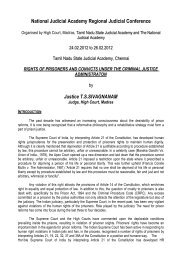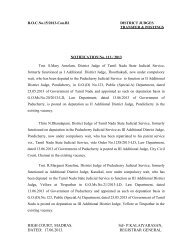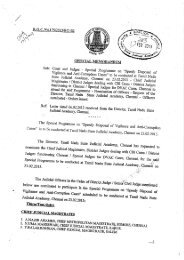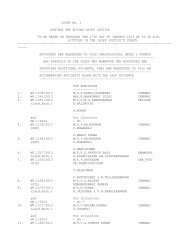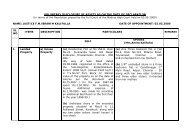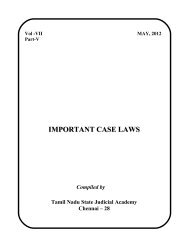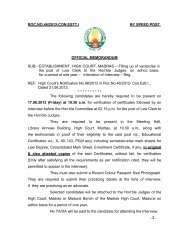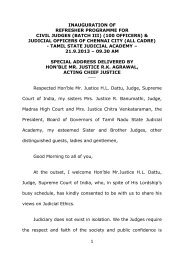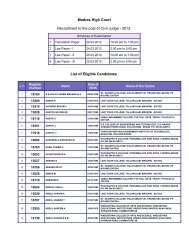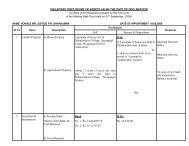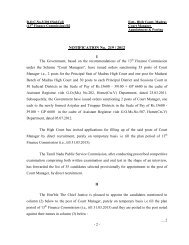IMPORTANT CASE LAWS - Madras High Court
IMPORTANT CASE LAWS - Madras High Court
IMPORTANT CASE LAWS - Madras High Court
Create successful ePaper yourself
Turn your PDF publications into a flip-book with our unique Google optimized e-Paper software.
Held:<br />
The Full Bench of the Appex <strong>Court</strong> in Sharda v. Dharmpal, 2003(2) CTC 760, differs from the Goutam Kuntu’s<br />
case as far as the direction No.5 above that no one can be compelled to give sample of blood for analysis. In Sharda’s case<br />
it has been held by the Apex <strong>Court</strong> that directing medical examination of a party to a matrimonial litigation cannot be held to<br />
be violative of one’s right to privacy, so also is not in violation of right of personal liberty under Article 21 of the Constitution.<br />
In both the decisions of the Honourable Supreme <strong>Court</strong>, it has been consistently held that the party who seeks direction for<br />
conducting D.N.A. Test shall not be ordered as a matter of course. The Supreme <strong>Court</strong> has not put complete prohibition on<br />
the power of the <strong>Court</strong> to order for D.N.A. Test. It is the view of the Supreme <strong>Court</strong> that as a routine practice, in all the<br />
cases such direction shall not be granted.<br />
As far as the facts of the present case are concerned, the Petitioner has made out a prima faice case. He has<br />
alleged that between 12.04.2001 and 25.5.2002 he had been away at Banagalore and he has not visited the Respondents<br />
house. Hence, there is no impediment to pass an order for D.N.A. Test in this case. In such a view of this matter, this <strong>Court</strong><br />
has to interfere with the order passed by the <strong>Court</strong> below, which is liable to be set aside and it is accordingly set aside. The<br />
Revision deserves to be allowed.<br />
2011 (2) CTC 642<br />
C.G. Jayaraman and Ors<br />
vs<br />
C. Gangadharan<br />
Code of Civil Procedure, 1908(5 of 1908), Section 100 & Order 41, Rule 31 – When concurring judgment is<br />
given, absence of elaborate discussion by Lower Appellate <strong>Court</strong> might not be fatal – But if a reversal finding is<br />
given, then Lower Appellate <strong>Court</strong> should given reasons on each and every findings of fact.<br />
Evidence Act, 1872 (1 of 1872), Section 63 – Secondary Evidence – Un-authenticated photocopy of a<br />
document cannot be produced as document to get it marked as secondary evidence – Approach of Lower Appellate<br />
<strong>Court</strong> relying on an inadmissible document, held, not justified.<br />
Legal Maxims – “Principiis obsta” – Withstand beginnings; Oppose a thing in its early stages, if you<br />
would do so with success.<br />
Legal Maxims – “Qui non negat fatetur” –He who does not deny, admits.<br />
Legal Maxims – “Jusdicis est judicare secundum allegata et probate” – It is duty of a Judge to decide<br />
according to facts alleged and prove<br />
Facts:<br />
Plaintiff obtained Jewel loan from the Bank. The Bank auctioned the jewels for non-payment of dues. Plaintiff<br />
claimed that he was ready to pay the money and the act of the Bank was excessive and therefore, filed a Suit claiming<br />
90,000/- as damages. The Trial <strong>Court</strong> dismissed his Suit. The Appellate <strong>Court</strong> reversed the finding as against which the<br />
Second Appeal was preferred. The <strong>High</strong> <strong>Court</strong> observed that the Lower Appellate <strong>Court</strong> had decided the case on the basis<br />
of an inadmissible document and had not substantiated reasoning for differing with the views of the Trial <strong>Court</strong>. <strong>High</strong> <strong>Court</strong><br />
consequently dismissed the Suit.<br />
Held:<br />
Trite the proposition of law is that in a Civil <strong>Court</strong>, a mere unauthenticated photocopy of a document cannot be<br />
produced as evidence. I am at a loss to understand, as to how the Trial <strong>Court</strong> simply entertained it and gave a marking to it<br />
as Ex.A1. No doubt, it is found mentioned in the relevant chief examination Affidavit itself that the original of Ex.A1 was filed<br />
27



